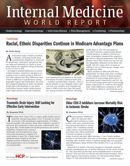Publication
Article
Internal Medicine World Report
Testosterone Treatment Put Under Many Microscopes
Author(s):
There had been a "remarkable convergence of many disciplines" when weighing the health risks and effectiveness of testosterone replacement therapy (TRT), according to an article published in JAMA.

There had been a “remarkable convergence of many disciplines” when weighing the health risks and effectiveness of testosterone replacement therapy (TRT), according to an article published in JAMA.
The lead author, Marc B. Garnick, MD, of Harvard Medical School and Beth Israel Deaconess Medical Center in Boston, cited the increase in use of TRT for primary and secondary hypogonadism, being used by 1,299,846 patients in 2010 and increasing to 2,291,266 users in 2013 — 60% were prescribed by primary care physicians.
With a majority of TRT subjects being 40 to 64 years, and 57% also taking cardiovascular medications, the need for analysis was considered dire. Even more concerning, Garnick cited one survey where out of 250,000 men, only 72% had testosterone testing conducted prior to undergoing treatment; 21% never had any claim; and only 6% had claims submitted after receiving their first TRT prescription.
“These data are noteworthy, because the indicated use of TRT has generally required a total testosterone value, usually ≤300 ng/dL on 2 morning samples. This metric has generally been recommended as an eligibility inclusion criteria for clinical studies aimed at attaining a TRT approval from the FDA,” he noted.
TRT’s approval was not initially intentioned for age-related hypogonadism, or low-T, since the FDA was not offered insight into the effects on older persons. Moreover, the safety of these drugs on this population was even more complicated as hypogonadism comes with symptoms that can be experienced by people not suffering from the condition.
“In practice, manufacturers of TRT products may have exploited...regulatory authority by introducing the low T disease concept followed by carefully scripted portrayals of actual products that address symptoms of low T,” Garnick wrote.
As a result, a panel overwhelmingly asserted that TRT treatments should not be used on men that were suffering from age-related testosterone decline. Specifically, the panel dictated that TRT be used strictly for classic hypogonadism, have a label alerting of cardiovascular risks, pressed for testosterone monitoring and that TRT for age-related hypogonadism hasn’t been proven to be effective. In response, the American Urological Association published a paper touting the panel’s determinations.
“The emergence of TRT as a multibillion-dollar industry without appropriate supporting data or oversight of its proper usage emphasizes the need for stricter controls as well as reassessment of approval pathways when the usage is not consistent with approved labeling,” Garnick added.
He concluded that the panel’s diligence provided concrete criterion for both patients and physicians to consider when (and if) starting treatment.






